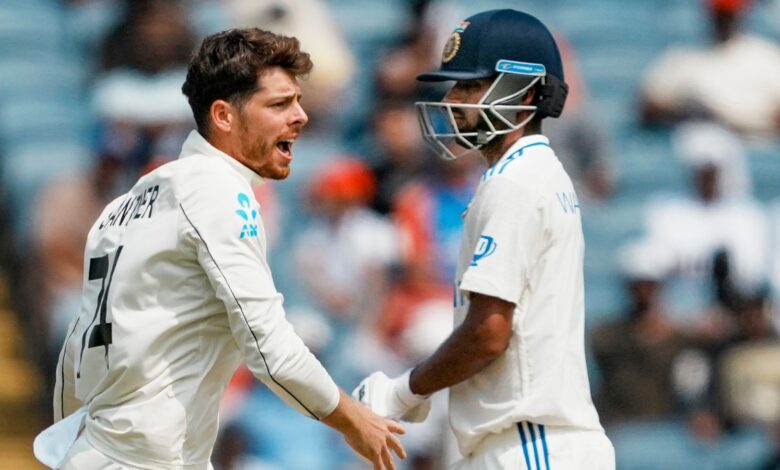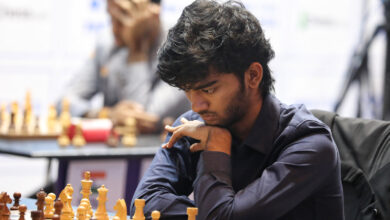India vs New Zealand Test: Indian spinners struggle to restrict Kiwi runs and resance as NZ lead goes past 300 | Cricket News

Who would have thought? That eleven days into the series, India would be staring into the eyes of their first series defeat at home in 12 years. That Tom Latham, captaincy thrust onto his shoulders after the calamitous Sri Lanka tour a fortnight ago, might become the first captain of his country to win a Test series in India. The age-old format’s powers to surprise flow unabated.
The result is not a foregone conclusion yet, even though the visitors’ overall lead had swelled to 301 with five wickets intact, courtesy Latham’s 86 and Mitchell Santner’s seven-wicket haul. The pitch is fairly free of demons to bat on, even though the odd ball grips and turns; some black soil pitches in the subcontinent tend to slow down as the game progresses, making batting a less tedious exercise on days three and four. A wounded India with their proud home record at stake, would be keen to atone for makes of the first innings. If the hes of the past teach us anything, it is that India would not surrender too abjectly. There could be phases in a game where they appear flaky, but when pushed to the corner, they invariably muster fight. The unfamiliar sight of victory on India shores could overawe the visitors yet.
India’s bowling coach Morne Morkel was gung-ho about the batting prowess of his team as well as the format’s capacity to produce miracles. “It’s a funny game, this cricket. Strange things can happen. India is a team that fights back, that will not give up too easily, and I’m sure they will come up with a strong performance, with the ball in the morning and the bat later on,” he said. The fans would rattle out blow blow accounts of Brisbane and Kolkata. Hope is the opium of cricket masses.
But the second day ended with New Zealand tightening their grip on the match. First, their spinners out-bowled the more feted India counterparts. Mitchell Santner and Glenn Phillips, who snared all 10 wickets between them, had a combined haul of 77 wickets at an average of 33. It’s eight wickets fewer than Ravi Ashwin had hoarded in the last two years. But their humble virtues—of discipline and diligence, aided the natural variations the surface threw up—humbled India’s batsmen.
When India lost wickets in clusters, it ignited the prospect of a hasty finish. If New Zealand’s spinners could winkle out India’s batsmen for a meagre total, so could theirs. The intrigue would intensify in the second session. A march past to the dressing room loomed. But it didn’t quite unfold that way. India waited 9.4 overs for the first breakthrough. the time Washington Sundar trapped Devon Conway plumb, 36 runs were already added to the first-innings deficit of 103.
This was the peril of surrendering a handsome lead. They were pushed to no man’s land where India’s bowlers could not attack full throttle, because a few fours and calculated risks would drift the game into the territory of unretrievable. New Zealand’s batsmen, with a newfound freedom, enlarged the cushion with gutsy batting. The wickets of Will Young and Rachin Ravindra in the space of 20 balls woke the sleepy crowd. But the stream of wickets that India required to swish a toehold into the game never arrived. Every new batsman offered runs and resance. Suddenly, the electronic scoreboard showed the lead had crossed 100, 150, 200 and 250.
Pune: India’s Washington Sundar with his teammates celebrates the wicket of New Zealand’s captain Tom Latham during the second day of the second test cricket match between India and New Zealand, at the Maharashtra Cricket Association Stadium, in Pune, Friday, Oct. 25, 2024. (PTI)
Often, the kiss of life arrived from Washington Sundar, who outshone Ashwin and Ravindra Jadeja, who between them managed only a solitary wicket. Both have been peripheral in this series. Ashwin has gobbled just five wickets; Jadeja only three at 67. This could be an aberration, but it was a prognosis that the fabulous spin twins are ageing and wearing, and a succession plan would be handy.
Not that India’s spin pair was lless. A few edges fell short of the fielders, several times the balls whizzed past the edges, some of the high-risk shots paid off, and a few decisions went marginally in New Zealand’s favour. Besides moure in the first session ensured that the strip had more bite and pace before the sun rendered it bone-dry. You could sympathise with them, yet acknowledge that the Kiwi duo out-bowled them. Aware of their limitations, they nagged a stump-to-stump line, whereas the India counterparts probed a more conventional fourth-fifth stump line.
Santner and Phillips were more persent with their lengths; they reproduced their white-ball expertise and dried up boundary balls, compelling India’s batsmen to embrace risks. Santner would speak about the partnership with Phillips. “It helped that we struck a good partnership, like one guy was looking to attack and the other was tying the other end. It helped in creating and maintaining pressure,” Santner revealed.
Ashwin and Co couldn’t. Runs flowed from both ends. New Zealand scored at nearly four an over until Rachin perished, pushing India to devise defensive measures. The usually thrifty Jadeja bled 4.54 runs an over. His bowling was bereft of the fizz that had devoured several batting line-ups on similar decks. “Can’t fault their efforts. We had good conversations and it’s about personal reflections, and putting this day behind,” Morkel said.
Either way, Saturday has the scope to define both cricketing nations. A horic first series triumph for Latham and his teammates or a miraculous escape for Rohit’s men. A lifetime’s opportunity wasted or the transition reality knocking on. None of these would have sounded plausible a fortnight ago. Eleven days ago, who would have thought?







